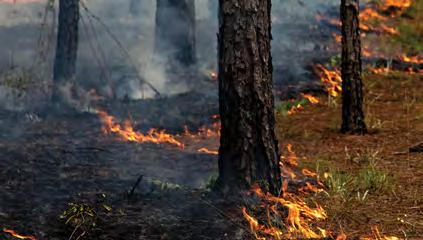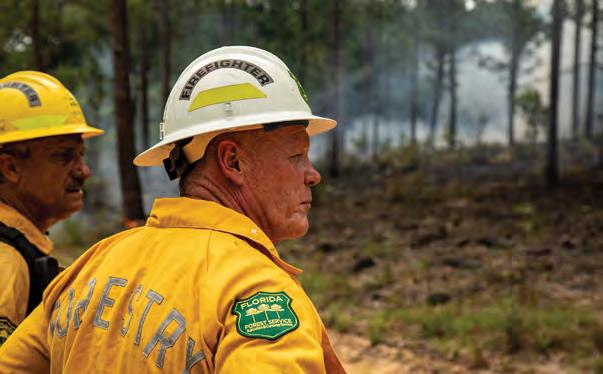
3 minute read
MEET JIM KARELS
FLORIDA’S FORMER STATE FORESTER, HOT THOUGHTS IN RETIREMENT

Written by: Jack Collier
It may seem weird, but fire is healthy in Florida. Good fire, however, as in prescribed burns, the kind professionals use to control bad fire. And the kind farmers use in processing state crops such as sugar cane, cattle pastures and timber forests.
Prescribed burns are an important tool to manage the lands in Florida. They bring many benefits, including reducing hazardous fuels that contribute to catastrophic wildfires, supporting a healthy ecosystem for wildlife, providing habitat for endangered species, minimizing invasive pests and disease, and recycling nutrients back into the soil.
Florida is a leader in prescribed or managed fires, especially in controlling the smoke from such burns. Pioneers in the Florida Division of Forestry completed models that allow for fire managers to tailor ignition locations and times to complete objectives under ideal conditions and appropriate seasons. The state adopted rules to reinforce what fire professionals determined was safe and necessary.
At the heart of this artform in keeping us safer is Jim Karels, Florida’s former State Forester and a leader in his profession. The trick in the future will be in limiting risk as our state population expands, as it is nearly 23 million now, should hit 25 million by 2030 and 30 million by 2050, or “really looking at how to manage a very large and growing population,” says Karels. “And we have to look at it from a standpoint … how do we manage the smoke?”
There is criticism that not enough precautions keep cane smoke in burn-offs from reaching towns. But those concerns are unfounded, as prescribed burns are based on sophisticated smoke models, he says, endorsed by Florida’s Department of Environmental Protection and federal agencies that oversee public health, clean water and air. “Mother Nature gets smoke anywhere she wants,” he adds, “and the one (remedy) that stands out, is how we manage that.”
Data show the system is working. Florida’s Department of Environmental Protection reported last year the Sunshine State had achieved the cleanest air on record. Florida meets all the National Ambient Air Quality Standards (NAAQS) statewide. Florida is the most populous state in the United States to meet these stringent federal standards.
Karels is an unquestioned leader in his field, was a lead investigator in the Yarnell Hill Fire in Arizona, a 2013 wildlife that reversed itself and trapped 19 members of the Granite Mountain Hotshots, for instance. Hotshots are specially trained in such work. Lightning ignited that fire. Only a Granite Mountain lookout in another location survived.
Karels was also president of the National Association of State Foresters and chair of that group’s Wildland Fire Committee. His advice and professional opinion on prescribed burns were of such importance that a committee in the US House of Representatives solicited his ideas in a 2017 hearing on air quality impacts of wildfires. In those written remarks, Karels expressed fears with years of raging wildfires, some 50,000 or so torching 8.4 million acres that year and solicited federal help in funding $2 billion for annual national forest service costs.
Congresspersons were also informed of “Good Neighbor” agreements between states and the feds in forest management and watershed restorations that can limit undergrowth that dries and fuels wildfires, “reducing those threats when conditions are right,” he adds in a conversation about work behind the scenes to keep fire at a minimum in Florida. Florida alone in an average year will prescribe burn more than 2 million acres, about 250,000 in state forests, issuing 90,000 permits in doing so, according to the Florida Department of Agriculture and Consumer Services, the regulating agency for such things. More than 11.3 million acres were treated in the United States with prescribed fire in 2017. The country has some 766 million acres of forests. Florida’s regulating agency has pages of resources to apply for permits and to learn about prescribed burns, such as times, fuel and weather conditions and other factors. Other states model themselves on what Florida first did in the 1970s.
FLORIDA ALONE IN AN AVERAGE YEAR WILL PRESCRIBE BURN MORE THAN 2 MILLION ACRES, ABOUT 250,000 IN STATE FORESTS, ISSUING 90,000 PERMITS.


Managing fire was thrust on Florida as new people flooded the state, many bringing their cultural views on burning from where it was often less threatening, certainly in the Northeast and Upper Midwest.

Managing fire was thrust on Florida as new people flooded the state, many bringing their cultural views on burning from where it was often less threatening, certainly in the Northeast and Upper Midwest, for instance. These immigrants to Florida wanted wooded lots or scrub pastures left untouched, concealed disasters, as prescribed burns were seen as destructive rather than healthy, says Karels. And these folks are often critical of so-called range burns, where growers will torch forty-acre blocks. Conditions must be perfect before permission is granted, as sugarcane, for instance, issues a smoke that gets directed away from population centers. “The is science in how (we) do the burning,” says Karels, a 35-year Florida Forest Service worker who is now 60, splitting retirement between Tallahassee and the National Interagency Fire Center in Boise, Idaho, adding that state certified burners must oversee crop burns.
“The entire state of Florida,” he adds, “evolved under fire. It is what made Florida Florida.” FCM
Roundup

Educate yourself on wildfires, prescribed burning, obtaining burn permits, land stewardship, or becoming a volunteer at such online sites as:


Tall Timbers talltimbers.org
Coalition of Prescribed Fire Councils, Inc. prescribedfire.net
National Interagency Fire Center nifc.gov
Florida Dept. of Agriculture and Consumer Services fdacs.gov










